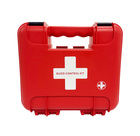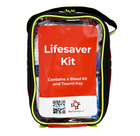Child CPR
Want to watch this video? Sign up for the course
or enter your email below to watch one free video.
Unlock This Video Now for FREE
This video is normally available to paying customers.
You may unlock this video for FREE. Enter your email address for instant access AND to receive ongoing updates and special discounts related to this topic.
Child CPR Guidelines
Overview
Child CPR differs from adult CPR due to the likelihood of respiratory issues rather than cardiac problems when a child stops breathing.
Definition
In CPR terms, a child is defined as someone aged between 1 and 18 years old.
Procedure
Initial Steps
When initiating CPR for a child, start with five rescue breaths to provide oxygen.
Compression Technique
- Compression Depth: Apply chest compressions at about one-third the depth of the chest, adjusted for the child's size.
- Compression Method: Use two hands if possible; one-handed compression may be necessary depending on the child's size.
Compression and Breathing Cycles
Perform cycles of 30 compressions followed by two breaths at a rate of 100 to 120 compressions per minute.
Conclusion
Continue CPR until medical assistance arrives, ensuring a defibrillator (AED) is available to potentially revive the child.
Recommended Products For You
Lifesaver Kit with Tourniquet - Red
£99.00 + VAT
Personal Bleed Kit in Belt Pouch - Black
£34.95 + VAT
Personal Bleed Kit in Belt Pouch - Red
£34.95 + VAT
WoundClot Trauma 8cm x 20cm
£17.95 + VAT
Bleed Control Kit In Red Titan Box
£55.00 + VAT
Animal First Aid Kit
£12.00 + VAT
Lifesaver Kit with Tourni-Key - Red
£85.00 + VAT
Woundclot Trauma Dressing 10cm x 10cm
£11.95 + VAT



_-Trauma_8x20_CE.jpg)



_-Trauma_10x10_CE.jpg)